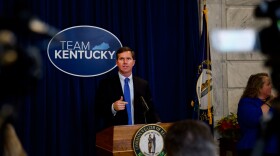A rise in coronavirus cases among Southern Indiana minority populations is prompting local health officials to take a more focused approach in combating the disease.
Lillian Rose, who serves hundreds of immigrants across the region at the Hispanic Connection of Southern Indiana, said there’s a lot about the spread of COVID-19 in the community that’s unknown — including reliable numbers about how many Hispanic residents have become infected or died from coronavirus.
“I can't tell you how many cases because no one will tell us,” Rose said. “I have no clue. I think I would have to go to the hospitals and figure out, ‘How many Hispanics did you have here?’”
Statewide, 11.7% of people who have tested positive for COVID-19 have been Hispanic, though they constitute roughly 7% of Indiana’s population. But the exact figures are still foggy, as the Indiana State Department of Health is reporting that ethnicity is “unknown” in 55% of cases.
Rose is open about the fact that many of the people she serves simply refuse to talk about the disease. It has developed a sort of stigma within the community, though she says she's not sure why. But what is known is that Clark County Health Officer Eric Yazel recently identified an uptick in positive tests seen among the Hispanic population.
To combat this spike seen in recent weeks, the Clark County Health Department has started printing flyers in Spanish. Yazel added that his team is also doing targeted outreach to contacts within the community to let people know what to expect during testing and contact tracing in an effort to alleviate potential concerns.
“Number one, we wanted to be clear that if there's any undocumented population, that that's not a focus of ours,” he said. “We just want to be able to give them their test results, so there's no issues there.”
Rose says there are several reasons the disease could be spreading in the Hispanic population. For one, many of the people she serves don’t have insurance. Those that do but don’t speak English fluently may have trouble communicating at local medical facilities, as translators can be hard to come by.
But she says the most significant factor of all is the need for Hispanic workers to sustain themselves and their families economically.
“The large majority did not stop working,” Rose said. “Even though they felt that their lives [were] at risk, the fact that they needed to put food on the table was more important.”
She added that some in the community weren’t able to qualify for the federal government’s stimulus payments, specifically non-citizens.
Yazel also made clear that he doesn’t believe the disproportionate impact in minority populations is something that can be fixed overnight. Rather, he believes it’s a systematic issue that has developed over decades. It’s his hope that an overhaul similar to that being called for in the justice system can also take place in the world of health care.
Pamela Clark, director of the minority health initiative at Community Action of Southern Indiana, is working towards a similar goal. Black Hoosiers already face an increased risk of medical conditions such as hypertension and diabetes. She said other socioeconomic factors and a higher level of overall mistrust in the system are also contributing to the heightened risk from COVID-19 faced by the Black community.
Less than 10% of the Hoosier population is Black, but right now that population accounts for 12.7% of all people to test positive for COVID-19 and 15.1% to die from it statewide.
“When you're talking about social determinants of health and where people live, work and play, that area already has issues going on economically within that community,” Clark said. “And then we put COVID-19 on top of that, on top of those issues. COVID-19 really brought a lot of concerns and things to the forefront, like racism that has come out.”
Clark expects a second wave of the virus to come through the area later this year. In the upcoming months, she said she will do as much as she can to better prepare the community for the disease. Part of this effort will focus on the health care side of the equation, such as making sure Jeffersonville has a state-sponsored testing facility this time around.
On the community side, Clark plans to push for better overall health within the Black community by promoting better diets and more exercise. One idea is to form a new coalition for the purpose of educating people about healthy lifestyles. Such a coalition would seek input from the community itself, local political leaders and the school system.
“It all ties into the educational system, because you know what, the more education you have, the healthier you are,” Clark said.






